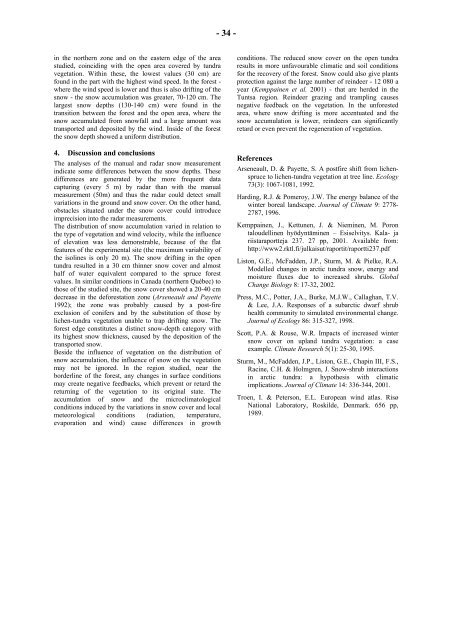Fourth Study Conference on BALTEX Scala Cinema Gudhjem
Fourth Study Conference on BALTEX Scala Cinema Gudhjem
Fourth Study Conference on BALTEX Scala Cinema Gudhjem
Create successful ePaper yourself
Turn your PDF publications into a flip-book with our unique Google optimized e-Paper software.
in the northern z<strong>on</strong>e and <strong>on</strong> the eastern edge of the area<br />
studied, coinciding with the open area covered by tundra<br />
vegetati<strong>on</strong>. Within these, the lowest values (30 cm) are<br />
found in the part with the highest wind speed. In the forest -<br />
where the wind speed is lower and thus is also drifting of the<br />
snow - the snow accumulati<strong>on</strong> was greater, 70-120 cm. The<br />
largest snow depths (130-140 cm) were found in the<br />
transiti<strong>on</strong> between the forest and the open area, where the<br />
snow accumulated from snowfall and a large amount was<br />
transported and deposited by the wind. Inside of the forest<br />
the snow depth showed a uniform distributi<strong>on</strong>.<br />
4. Discussi<strong>on</strong> and c<strong>on</strong>clusi<strong>on</strong>s<br />
The analyses of the manual and radar snow measurement<br />
indicate some differences between the snow depths. These<br />
differences are generated by the more frequent data<br />
capturing (every 5 m) by radar than with the manual<br />
measurement (50m) and thus the radar could detect small<br />
variati<strong>on</strong>s in the ground and snow cover. On the other hand,<br />
obstacles situated under the snow cover could introduce<br />
imprecisi<strong>on</strong> into the radar measurements.<br />
The distributi<strong>on</strong> of snow accumulati<strong>on</strong> varied in relati<strong>on</strong> to<br />
the type of vegetati<strong>on</strong> and wind velocity, while the influence<br />
of elevati<strong>on</strong> was less dem<strong>on</strong>strable, because of the flat<br />
features of the experimental site (the maximum variability of<br />
the isolines is <strong>on</strong>ly 20 m). The snow drifting in the open<br />
tundra resulted in a 30 cm thinner snow cover and almost<br />
half of water equivalent compared to the spruce forest<br />
values. In similar c<strong>on</strong>diti<strong>on</strong>s in Canada (northern Québec) to<br />
those of the studied site, the snow cover showed a 20-40 cm<br />
decrease in the deforestati<strong>on</strong> z<strong>on</strong>e (Arseneault and Payette<br />
1992); the z<strong>on</strong>e was probably caused by a post-fire<br />
exclusi<strong>on</strong> of c<strong>on</strong>ifers and by the substituti<strong>on</strong> of those by<br />
lichen-tundra vegetati<strong>on</strong> unable to trap drifting snow. The<br />
forest edge c<strong>on</strong>stitutes a distinct snow-depth category with<br />
its highest snow thickness, caused by the depositi<strong>on</strong> of the<br />
transported snow.<br />
Beside the influence of vegetati<strong>on</strong> <strong>on</strong> the distributi<strong>on</strong> of<br />
snow accumulati<strong>on</strong>, the influence of snow <strong>on</strong> the vegetati<strong>on</strong><br />
may not be ignored. In the regi<strong>on</strong> studied, near the<br />
borderline of the forest, any changes in surface c<strong>on</strong>diti<strong>on</strong>s<br />
may create negative feedbacks, which prevent or retard the<br />
returning of the vegetati<strong>on</strong> to its original state. The<br />
accumulati<strong>on</strong> of snow and the microclimatological<br />
c<strong>on</strong>diti<strong>on</strong>s induced by the variati<strong>on</strong>s in snow cover and local<br />
meteorological c<strong>on</strong>diti<strong>on</strong>s (radiati<strong>on</strong>, temperature,<br />
evaporati<strong>on</strong> and wind) cause differences in growth<br />
- 34 -<br />
c<strong>on</strong>diti<strong>on</strong>s. The reduced snow cover <strong>on</strong> the open tundra<br />
results in more unfavourable climatic and soil c<strong>on</strong>diti<strong>on</strong>s<br />
for the recovery of the forest. Snow could also give plants<br />
protecti<strong>on</strong> against the large number of reindeer - 12 080 a<br />
year (Kemppainen et al. 2001) - that are herded in the<br />
Tuntsa regi<strong>on</strong>. Reindeer grazing and trampling causes<br />
negative feedback <strong>on</strong> the vegetati<strong>on</strong>. In the unforested<br />
area, where snow drifting is more accentuated and the<br />
snow accumulati<strong>on</strong> is lower, reindeers can significantly<br />
retard or even prevent the regenerati<strong>on</strong> of vegetati<strong>on</strong>.<br />
References<br />
Arseneault, D. & Payette, S. A postfire shift from lichenspruce<br />
to lichen-tundra vegetati<strong>on</strong> at tree line. Ecology<br />
73(3): 1067-1081, 1992.<br />
Harding, R.J. & Pomeroy, J.W. The energy balance of the<br />
winter boreal landscape. Journal of Climate 9: 2778-<br />
2787, 1996.<br />
Kemppainen, J., Kettunen, J. & Nieminen, M. Por<strong>on</strong><br />
taloudellinen hyödyntäminen – Esiselvitys. Kala- ja<br />
riistaraportteja 237. 27 pp, 2001. Available from:<br />
http://www2.rktl.fi/julkaisut/raportit/raportti237.pdf<br />
List<strong>on</strong>, G.E., McFadden, J.P., Sturm, M. & Pielke, R.A.<br />
Modelled changes in arctic tundra snow, energy and<br />
moisture fluxes due to increased shrubs. Global<br />
Change Biology 8: 17-32, 2002.<br />
Press, M.C., Potter, J.A., Burke, M.J.W., Callaghan, T.V.<br />
& Lee, J.A. Resp<strong>on</strong>ses of a subarctic dwarf shrub<br />
health community to simulated envir<strong>on</strong>mental change.<br />
Journal of Ecology 86: 315-327, 1998.<br />
Scott, P.A. & Rouse, W.R. Impacts of increased winter<br />
snow cover <strong>on</strong> upland tundra vegetati<strong>on</strong>: a case<br />
example. Climate Research 5(1): 25-30, 1995.<br />
Sturm, M., McFadden, J.P., List<strong>on</strong>, G.E., Chapin III, F.S.,<br />
Racine, C.H. & Holmgren, J. Snow-shrub interacti<strong>on</strong>s<br />
in arctic tundra: a hypothesis with climatic<br />
implicati<strong>on</strong>s. Journal of Climate 14: 336-344, 2001.<br />
Troen, I. & Peters<strong>on</strong>, E.L. European wind atlas. Risø<br />
Nati<strong>on</strong>al Laboratory, Roskilde, Denmark. 656 pp,<br />
1989.













